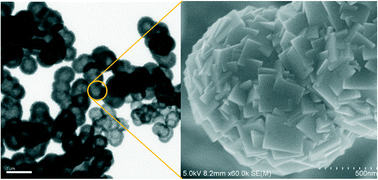Facile synthesis of TiO2 hollow spheres composed of high percentage of reactive facets for enhanced photocatalytic activity†
Abstract
In this study, facile synthesis of hollow TiO2 spheres composed of a high percentage of reactive facets (~85%) is successfully prepared with TiOSO4 and HBF4 by the hydrothermal method. Results reveal that hollow TiO2 spheres of 605 nm to 1.21 μm in size are in the anatase phase with sulfur doping. The variation in shell morphologies (e.g. polyhedron and nanosheet) can be realized by adjusting the reactant concentrations, while the molar ratio of TiOSO4 to HBF4 is maintained at 5 : 3. Based on the time-dependent morphology evolution study, the growth mechanism of hollow structure formation via self-templating and dissolution–recrystallization processes is discussed. The effects of reactant concentrations on TiO2 morphology are investigated to understand the dual roles of HBF4. Results also indicate that hollow TiO2 spheres with nanosheet morphology having 85% (001) facets exhibit 1.4–5 times higher performance than their counterparts in photocatalytic hydrogen production. The enhanced photocatalytic activity is ascribed to the combined effects of their unique hollow structure, high BET specific surface area (139.1 m2 g−1) and high percentage of exposed reactive facets (85%). This study demonstrates a promising strategy for large-scale production of hollow TiO2 spheres using a template- and surfactant-free process for photocatalysis applications.


 Please wait while we load your content...
Please wait while we load your content...